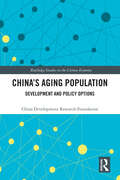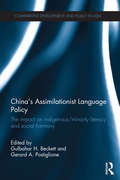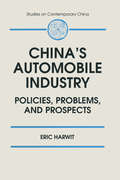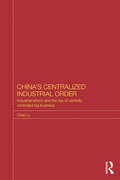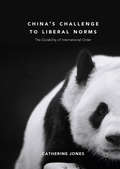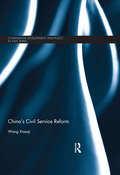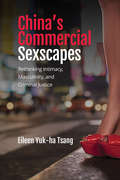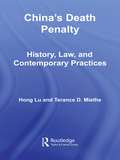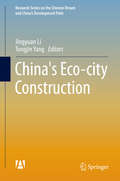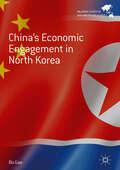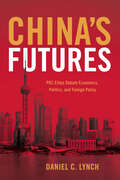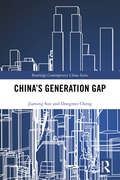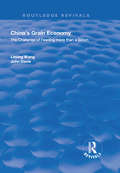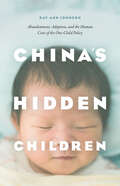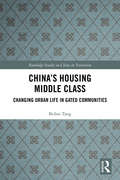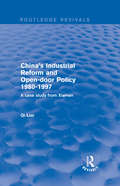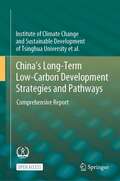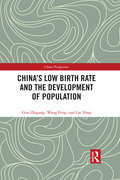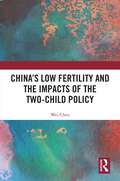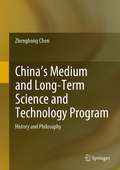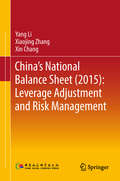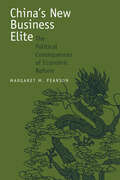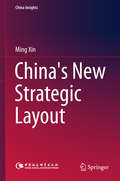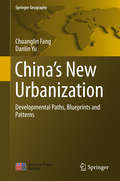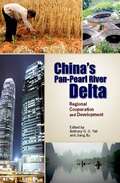- Table View
- List View
China's Aging Population: Development and Policy Options (Routledge Studies on the Chinese Economy)
by China Development Research FoundationThis book provides a systematic study of the challenges of aging in China and of the measures being taken, planned, and still needed to cope with the challenges. It highlights that the number of people aged 65 or above is growing and that the growth will accelerate—from 176 million people representing 12.6% of the population in 2019 to 310 million representing 22.3% of the population by 2035, and it also highlights that the aging comes at a time when China’s economy is not yet fully developed and not yet fully balanced. The book outlines how China has already established an elderly care system and is beginning to meet the needs of the elderly for economic security, social services, and so on; discusses the need for enhancing and considerably extending the existing system; and proposes reform ideas and key policy options.
China's Assimilationist Language Policy: The Impact on Indigenous/Minority Literacy and Social Harmony (Comparative Development and Policy in Asia)
by Gerard A. Postiglione Gulbahar H. BeckettChina has huge ethnic minorities – over 40 different groups with a total population of over 100 million. Over time China’s policies towards minority languages have varied, changing from policies which have accommodated minority languages to policies which have encouraged integration. At present integrationist policies predominate, notably in the education system, where instruction in minority languages is being edged out in favour of instruction in Mandarin Chinese. This book assesses the current state of indigenous and minority language policy in China. It considers especially language policy in the education system, including in higher education, and provides detailed case studies of how particular ethnic minorities are being affected by the integrationist, or assimilationist, approach.
China's Automobile Industry: Policies, Problems and Prospects (Studies On Contemporary China)
by Eric HarwitThe author presents an argument for a system of social insurance that replaces welfare with a Guaranteed Adequate Income. The book reviews public assistance programmes, and evaluates other plans that have been proposed.
China's Centralized Industrial Order: Industrial Reform and the Rise of Centrally Controlled Big Business (Routledge Studies on the Chinese Economy)
by Chen LiThis book is about the political economy of China’s industrial reform and the rise of a group of Chinese big businesses under the Communist Party and the central state’s control. It examines the origins, evolution and institutional configuration of this centralized system in governing the ‘commanding heights’ of the Chinese industrial economy. Shaped by persistent industrial policies to develop China’s ‘national champions’ enterprises, the core parts of China’s central industrial ministries and mono-bank system have been transformed into a ‘national team’ of giant modern business firms in industries such as oil, power generation, telecommunications, aerospace, aviation, nuclear, shipbuilding, mining, construction, automobile and banking. Through an adaptive process of learning, experimentation and restructuring, the bedrock of the authority relations and control mechanisms among the Party, government bureaucracy and firms has been consolidated rather than dismantled in the system’s transformation. This alternative view of China’s industrial reform presents a direct challenge to the neo-liberal transition model of China’s institutional development and the mainstream Western conceptions of Chinese big business.
China's Challenge to Liberal Norms: The Durability Of International Order
by Catherine JonesIs China challenging liberal norms or being socialised to them? This book argues that China is incrementally pushing for re-interpretation of liberal norms, but, the result is that rather than being illiberal, this reinterpretation produces norms that are differently liberal and more akin to the liberal pluralism of the 1990s. In developing this argument, the author presents a novel way to understand and assess these incremental changes, and the causes of them. The book’s empirical chapters explore China’s views on norms of sovereignty and intervention, and aid and development, contrasting them against the current western liberal practices, but making the case that they are congruent with the attitudes understood as being broadly liberal-pluralist. This book will appeal to students seeking to understand how rising states may affect the current institutions of international order, and make assessments of how fast that order may change. It will also appeal to scholars working on China and institutions by aiding the development of new lines of enquiry.
China's Civil Service Reform (Comparative Development and Policy in Asia)
by Wang XiaoqiA market economy and a more liberal society have brought great challenges to China’s outdated governance structure and personnel management. To improve decision-making in government and reshape the management system in face of a more complex economy, post-Mao authorities have implemented a number of administrative reforms, including civil service reform which emphasized on selecting and promoting public officials based on their capability and work performance. Thousands of positions have been filled since the civil service system was implemented nationwide in 1993. The Chinese civil service reform is of far-reaching significance because it had the potential to be a departure from the established structure of cadre personnel management system developed in the 1950s. However, after several years of policy development, scholars observe that the new reforms have done little to undermine the old cadre system. Is this true? Or does this conclusion over-simplify the complicated implementation of the reforms? This book examines the implementation and performance of the on-going civil service reforms in China. Using the principal-agent framework, the author draw upon key case studies showing how the reforms affect civil servants’ incentives and behavior in the local context and the Chinese leadership’s control over the bureaucracy. China’s reform experience speaks directly to many Asian countries facing urgent need to improve state capacity as the global financial crisis unfolds.
China's Commercial Sexscapes: Rethinking Intimacy, Masculinity, and Criminal Justice
by Eileen Yuk-ha TsangExploring the experiences of both male clients and female sex workers, China’s Commercial Sexscapes expands upon the complex dynamics of sex worker and client relationships, and places them within the wider implications of expanding globalization and capitalism. The purchasing of commercial sex by single, young-adult males is increasingly viewed as a socially acceptable way for men to pay for the opportunity to perform and experience heteronormative masculinity. Investigating human rights, social policy, and the criminal justice system in China, China’s Commercial Sexscapes applies the concept of ‘edgework’ in Dongguan, the most explicit, complicated, and multidimensional setting, to study how men and women interact within the changing global economy after the global financial crisis in China.
China's Death Penalty: History, Law and Contemporary Practices (Routledge Advances in Criminology #5)
by Terance D. Miethe Hong LuBy all accounts, China is the world leader in the number of legal executions. Its long historical use of capital punishment and its major political and economic changes over time are social facts that make China an ideal context for a case study of the death penalty in law and practice. This book examines the death penalty within the changing socio-political context of China. The authors'treatment of China' death penalty is legal, historical, and comparative. In particular, they examine; the substantive and procedures laws surrounding capital punishment in different historical periods the purposes and functions of capital punishment in China in various dynasties changes in the method of imposition and relative prevalence of capital punishment over time the socio-demographic profile of the executed and their crimes over the last two decades and comparative practices in other countries. Their analyses of the death penalty in contemporary China focus on both its theory - how it should be done in law - and actual practice - based on available secondary reports/sources.
China's Eco-city Construction (Research Series on the Chinese Dream and China’s Development Path)
by Jingyuan Li Tongjin YangThis book introduces the concept of Eco-civilization, highlights the construction and development of eco-cities in China, and assesses the achievements and shortcomings of China's eco-city construction projects. As both China and Western countries face an impending ecological crisis, responding to that crisis is a common challenge for all human beings. There is an overwhelming consensus among Chinese scholars that in order to successfully address the ecological crisis successfully we must establish an eco-civilization, and one important step toward accomplishing that goal is to plan and construct eco-cities.
China's Economic Engagement in North Korea (Palgrave Series in Asia and Pacific Studies)
by Bo GaoThis book addresses growing tensions in Northeast Asia, notably between North Korea and China. Focusing on China’s economic participation in North Korea’s minerals and fishery industries, the author explores the role of China’s sub-state and non-state actors in implementing China’s foreign economic policy towards North Korea. The book discusses these actors’ impact on the regional order in Northeast Asia, particularly in the Korean Peninsula. The project also provides a comprehensive and up-to-date account of China’s cultural and economic activities in North Korea as implemented by both the historically traditional actors in Jilin and Liaoning provinces in Northeast China, and new actors from coastal areas (Shandong and Zhejiang provinces) and inland provinces (Chongqing and Henan) to Zhejiang province. It argues that in the era of economic decentralisation, Chinese sub-state and non-state actors can independently deal with most of their economic affairs without the need for permission from the central government in Beijing. A key read for scholars and students interested in Asian history, politics and economics, and specifically the East Asian situation, this text offers an in-depth analysis of recent activity concerning the Sino-DPRK economic relationship.
China's Futures: PRC Elites Debates Economics, Politics, and Foreign Policy
by Daniel C. LynchChina's Futures cuts through the sometimes confounding and unfounded speculation of international pundits and commentators to provide readers with an important yet overlooked set of complex views concerning China's future: views originating within China itself. Daniel Lynch seeks to answer the simple but rarely asked question: how do China's own leaders and other elite figures assess their country's future? Many Western social scientists, business leaders, journalists, technocrats, analysts, and policymakers convey confident predictions about the future of China's rise. Every day, the business, political, and even entertainment news is filled with stories and commentary not only on what is happening in China now, but also what Western experts confidently think will happen in the future. Typically missing from these accounts is how people of power and influence in China itself imagine their country's developmental course. Yet the assessments of elites in a still super-authoritarian country like China should make a critical difference in what the national trajectory eventually becomes. In China's Futures, Lynch traces the varying possible national trajectories based on how China's own specialists are evaluating their country's current course, and his book is the first to assess the strengths and weaknesses of "predictioneering" in Western social science as applied to China. It does so by examining Chinese debates in five critical issue-areas concerning China's trajectory: the economy, domestic political processes and institutions, communication and the Internet (arrival of the "network society"), foreign policy strategy, and international soft-power (cultural) competition.
China's Generation Gap (Routledge Contemporary China Series)
by Jiaming Sun Dongmei ChengBased on data collected for the Generation Gap Survey in Shanghai and updated to take into account contemporary trends, this book uses an empirical approach to study the generation gap in China. It covers various aspects of life from professional and family life to political participation and belief systems, analysing and comparing the values held by four different generations. Encompassing more than 2000 case studies and drawing on a wealth of fieldwork interviews, in particular it examines the experiences, thoughts and perceptions of adolescents, young adults, the middle-aged, and the elderly. As the largest sociological survey ever conducted regarding attitudes and value changes by different age groups in Shanghai, it highlights how social change and globalization have impacted on new generations, and the results indicate the dramatic difference and supersession of social ideologies between the generations. A unique piece of research, shedding light on a changing Chinese society, China’s Generation Gap will be of huge value to students and scholars of Chinese culture and society, Chinese social policy, globalisation and cultural studies.
China's Grain Economy: The Challenge of Feeding More Than a Billion (Routledge Revivals)
by John Davis Liming WangThis book was originally pubished in 2000. China is the largest developing country in the world and is still heavily based on agriculture. Currently, about 70 per cent of China's total of more than one bilion people live in rural areas, and about half of the total national labour force is involved in agricultural activities. It is clear that agriculture is the foundation for the development of the Chinese national economy. Within agriculture, the grain economy is the most important sector: indeed it has been recognised as a treasure in managing the country by all past Chinese dynasties. Ensuring enough grain supply to meet the demands of such a huge population seems to be a long-term goal for the Chinese government and this book explores whether China will be able to produce enough grain to keep pace with its population increases.
China's Hidden Children: Abandonment, Adoption, and the Human Costs of the One-Child Policy
by Kay Ann JohnsonIn the thirty-five years since China instituted its One-Child Policy, 120,000 children--mostly girls--have left China through international adoption, including 85,000 to the United States. It's generally assumed that this diaspora is the result of China's approach to population control, but there is also the underlying belief that the majority of adoptees are daughters because the One-Child Policy often collides with the traditional preference for a son. While there is some truth to this, it does not tell the full story--a story with deep personal resonance to Kay Ann Johnson, a China scholar and mother to an adopted Chinese daughter. Johnson spent years talking with the Chinese parents driven to relinquish their daughters during the brutal birth-planning campaigns of the 1990s and early 2000s, and, with China's Hidden Children, she paints a startlingly different picture. The decision to give up a daughter, she shows, is not a facile one, but one almost always fraught with grief and dictated by fear. Were it not for the constant threat of punishment for breaching the country's stringent birth-planning policies, most Chinese parents would have raised their daughters despite the cultural preference for sons. With clear understanding and compassion for the families, Johnson describes their desperate efforts to conceal the birth of second or third daughters from the authorities. As the Chinese government cracked down on those caught concealing an out-of-plan child, strategies for surrendering children changed--from arranging adoptions or sending them to live with rural family to secret placement at carefully chosen doorsteps and, finally, abandonment in public places. In the twenty-first century, China's so-called abandoned children have increasingly become "stolen" children, as declining fertility rates have left the dwindling number of children available for adoption more vulnerable to child trafficking. In addition, government seizures of locally--but illegally--adopted children and children hidden within their birth families mean that even legal adopters have unknowingly adopted children taken from parents and sent to orphanages. The image of the "unwanted daughter" remains commonplace in Western conceptions of China. With China's Hidden Children, Johnson reveals the complex web of love, secrecy, and pain woven in the coerced decision to give one's child up for adoption and the profound negative impact China's birth-planning campaigns have on Chinese families.
China's Housing Middle Class: Changing Urban Life in Gated Communities (Routledge Studies on China in Transition)
by Beibei TangHome ownership plays a significant role in locating the middle class in most western societies, associated with market, consumerism, democracy and “people like us”, the significant features of the middle class for any society. In China, private home ownership was not the norm from 1949, when the Chinese Communist Party took power, until the 1990s. In the past three decades, however, there has been a fast growing housing consumption and private homeowners have become the most significantly changing aspect of Chinese urban life. In particular, the rise of gated communities has become a predominant feature of the urban landscape. Similar to their western counterparts, the gated communities in China exemplify “high status” symbols with enclosed and restricted residential areas, exclusive community parks and recreational facilities, and professional management and security services. But different from western societies where gated communities usually represent luxurious lifestyles only limited to a small group of people, in urban China gated communities have become one major form of supply in the housing market and one of the most popular and desirable choices for homebuyers. Private home ownership and residency in gated communities, altogether characterize the most significant aspect of comfort living and distinct lifestyles of China’s new middle classes who have successfully got ahead in the socialist market economy. This book examines the formation of “China’s housing middle class”. It develops a theoretical argument about, and provides empirical evidence of the heterogeneity of China’s new middle class, which underlines the relations between the state, market and life chances under a socialist market economy. As such it will be of huge interest to students and scholars of Chinese society, sociology and politics.
China's Industrial Reform and Open-door Policy 1980-1997: A Case Study from Xiamen (Routledge Revivals)
by Qi LuoThis title was first published in 2001. The 1980s and 1990s were not only a period in which many developing countries adopted a series of major economic policy reforms, but also an era in which all socialist countries undertook varying degrees of radical reforms in their Soviet-style central-planning economic management systems. This volume examines the performance of China's industrial reform and open-door policy during the period of 1980-1997 through conducting a case study on one of its Special Economic Zones (SEZs), Xiamen. It adopts an analytical approach - examining Xiamen's performance from the perspective of three important interactions: between the country's general economic reform policies and the Special Policy implemented in the SEZs; between the Xiamen SEZ and the vast Chinese hinterland; and between foreign (especially Taiwanese) direct investment and local industrial transformation.
China's Long-Term Low-Carbon Development Strategies and Pathways: Comprehensive Report
by Institute of Climate Change and Sustainable Development of Tsinghua University et al.This open access book introduces a multi-disciplinary and comprehensive research on China's long-term low-carbon emission strategies and pathways. After comprehensively considering China’s own socioeconomic conditions, policy design, energy mix, and other macro-development trends and needs, the research team has proposed suggestions on China’s low-carbon development strategies and pathways until 2050, with required technologies and policies in order to realize the goals of building a great modern socialist country and a beautiful China. These achievements are in conjunction with the climate goals set in the Paris Agreement alongside Global Sustainable Development. The authors hope that the research findings can serve as a reference for all sectors of Chinese society in their climate research efforts, offer support for the formulation and implementation of china’s national low-carbon development strategies and policies, and help the world to better understand China’s story in the general trend of global green and low-carbon development.
China's Low Birth Rate and the Development of Population (China Perspectives)
by Wang Feng Guo Zhigang Cai YongAs the most populous country in the world, China’s demographic challenges have always been too many people for ecological system, resources, and the environment. However, by the early 1990s, fertility rate in China had dropped below the replacement level, and China’s low fertility has now attracted the world’s attention. This book is among the first studies to raise and examine questions on low fertility in China, believing that China has entered a new era featured by low birth rate and ageing population. Utilizing advanced research methods and models on low fertility to analyze China’s census data, this book explores the issues from various perspectives. Methodologies employed in past population studies, policy making concerning fertility rate, underreporting of births and fertility rate estimates, fertility level of the migrant population, current population pattern, long-term population trends, population dynamics, and many other thought-provoking problems are covered. Finally, the book revisits China’s population issues in the context of globalization. The 21st century has seen the new challenge of persistent population decrease and ageing worldwide, which, along with economic globalization, demands a new understanding of the changes in population pattern and their consequences. Researchers and students in China’s demographic and social studies will be attracted by the insightful analysis and rich materials provided in the book. Population policy makers will also benefit from it.
China's Low Fertility and the Impacts of the Two-Child Policy
by Wei ChenThis book examines China’s fertility transition over the past seven decades and explores the socioeconomic impacts of the two-child policy. The first half of the book highlights the characteristics of China’s low fertility and the risk of falling to an ultra-low state, aiming to answer the question: How China’s fertility is changing and evolving? How common is China’s fertility? What are the demographic structure, driving forces and institutional characteristics of China’s low fertility? The second half models the impacts of the two-child policy on China’s population trends and demands for women, infant and child health services, education resources for preschool, compulsive education, and medical and health expenditure, addressing the questions of how the two-child policy affects fertility behaviours of Chinese women, particularly the second-child fertility? How would the two-child policy impact China’s future population trends, particularly labour supply and population ageing? What are the consequences for obstetrics and gynaecological services, paediatrics and childcare services; and for school capacity and demand for teachers over compulsory education? The book will be an essential read to students and scholars of Chinese studies, population and demography studies, and those interested in contemporary China.
China's Medium and Long-Term Science and Technology Program: History and Philosophy
by Zhenghong ChenThis book conducts a panoramic study on the history of China’s Science and Technology which focuses on the Medium and Long-Term Science and Technology Program (MLSTP). In general these Programs have a duration of 5-30 year. This book provides an epochal assessment of the project’s conceptual context over the past 60 years.. The author shows that the historical evolution and conceptual development of China’s MLSTP are the result of an amalgamation of political, economic and social factors within distinct contemporary contexts. As a national action plan, MLSTP has incorporated many of the factors that go beyond the intentional factors of science and technology. MLSTP is not only a macro vision and blueprint for scientific and technological development; it is also a political act of realizing the national will. While ensuring the MLSTP builds on its great achievements, the author also reflects upon its deficiencies and disadvantages in order to better promote the advancement of science and technology in China.This book comprehensively lays out the historical and theoretical dimensions. Based on a clear vision of historical constructivism the author has compiled the MLSTP philosophy of different eras into a conceptual framework for this era and used this framework to research and analyze the historical and conceptual evolution of MLSTP. Research on MLSTP is important for as enrichment of contemporary studies in the history of science and the science and technology policy. In 2010, more than 60 years after the establishment of the People’s Republic of China, the country had enacted 10 MLSTP programs.This book separates the development of the MLSTP into three different historical eras: the era of economic planning, the era of economic transformation and the new century. Each historical epoch corresponds to a different MLSTP philosophy concept, which enables us to study the conceptual evolution of MLSTP using historical research as our foundation.
China's National Balance Sheet: Leverage Adjustment and Risk Management
by Xiaojing Zhang Xin Chang Yang LiThe book aims at perfecting the national governance system and improving national governance ability. It evaluates the balance sheets of the state and residents, non-financial corporations, financial institutions and the central bank, the central government, local government and external sectors – the goal being to provide a systematic analysis of the characteristics and trajectory of China’s economic expansion and structural adjustment, as well as objective assessments of short and long-term economic operations, debt risks and financial risks with regard to the institutional and structural characteristics of economic development in market-oriented reform. It puts forward a preliminary analysis of China’s national and sectoral balance sheets on the basis of scientific estimates of various kinds of data, analyzes from a new perspective the major issues that are currently troubling China – development sustainability, government transformation, local government debt, welfare reform, and the financial opening-up and stability – and explores corresponding policies, measures, and institutional arrangements.
China's New Business Elite: The Political Consequences of Economic Reform
by Margaret M. PearsonThe transition from a planned to a market economy that began in China in the late 1970s unleashed an extraordinary series of changes, including increases in private enterprise, foreign investment, the standard of living, and corruption. Another result of economic reform has been the creation of a new class—China's new business elite. Margaret M. Pearson considers the impact that this new class is having on China's politics. She concludes that, contrary to the assumptions of Westerners, these groups are not at the forefront of the emergence of a civil society; rather, they are part of a system shaped deliberately by the Chinese state to ensure that economic development will not lead to democratization.
China's New Strategic Layout (China Insights)
by Ming XinThis book, based on the Chinese dream and its basic principles, global significance, path of implementation and practical requirements, systemically explains China's Four-Pronged Comprehensive Strategy. The Four-Pronged Comprehensive Strategy is the strategic concept of the Communist Party of contemporary China. In the coming five and even the fifty years, the economic and social development of the Chinese society will be centering on it. Comprehensively constructing a moderately prosperous society is the strategic goal, comprehensively deepening reform and advancing the law-based governance of China are the engine and guarantee in realizing the strategic goal, while strengthening the Party Self-discipline represents the strategic measures to build up a firm core leadership. The Four-Pronged Comprehensive Strategy shows not only the CPC's view of China but also the view of world.
China's New Urbanization: Developmental Paths, Blueprints and Patterns (Springer Geography)
by Chuanglin Fang Danlin YuThis book answers the call for NewUrbanization, and proposesa "5+9+6" nationalspatial layout plan for the urbanizationof the 770 major cities in China. This macro pattern is based on a fewmajor metropolises at the center, and other cities supporting and benefitting from thesemetropolises to form a pyramid-like urban hierarchical system. The book also presents a comprehensiveregionalization plan for China's New Urbanization and strategic approaches to improving the quality of thisNew Urbanization. Currently, China is aggressively promoting a so-called New Urbanization, which has been regarded as one of the primaryways to build a moderately prosperous society, to address critical issuesrelated to agriculture,rural regions and farmers, to expand domestic demand and promote industrial innovation, and to realize the China Dream. From a systematic perspective and using recently released urban data, theauthors analyze the current status of New Urbanization in China and also investigatethe various potential problems and obstacles to its concrete implementation. Based on the analysesand investigations, the authors propose strategic directions, paths and basicprinciples for China's New Urbanization. In addition, they clearly identify the three differentmodes of New Urbanization, namely, the general mode, differentiated mode, and gradual mode. Today, many scholars argue that China's urban regions areexperiencing a highly unsustainable mode of development. Chinese cities areheavily burdened by theso-called "urban diseases,"which are characterized e. g. by congested traffic, polluted water and air, and a lack of open and green spaces. Traditionalurbanization, which primarily focuseson economic development, mustbe fundamentally reformed. New Urbanization, which focuses on integrated economic development,social integration and space/environmental sustainability, or simply put, on the quality ofurbanization, has been called for to provide a potential "cure" for these urban diseases. Due to the vastness of China'spopulation and its rapidly growing economic, political and cultural relationshipswith the rest of the world,the book demonstrates thatthe success of this New Urbanization is critical not only to the future of urban China,but also the future of urbanization worldwide. Thebook offers a valuable referencework for all researchers, graduate student and policy makers interestedin China's urban development.
